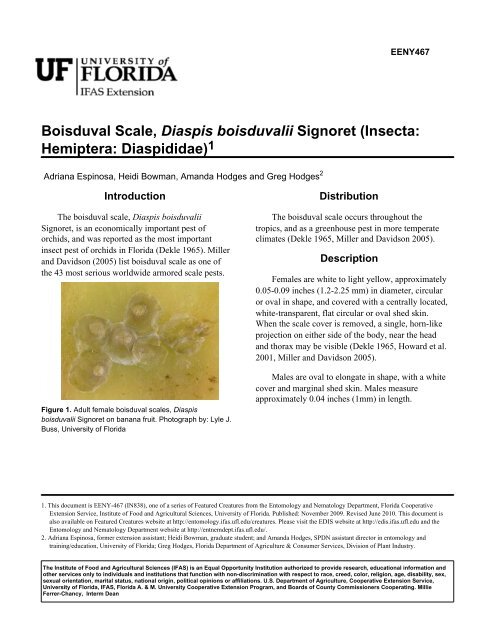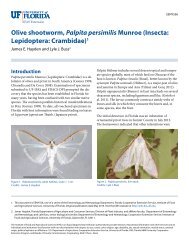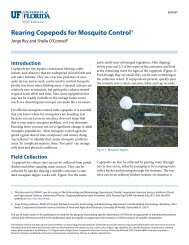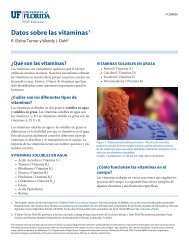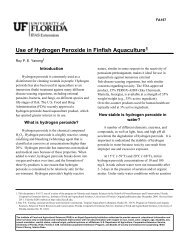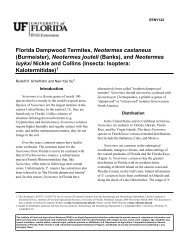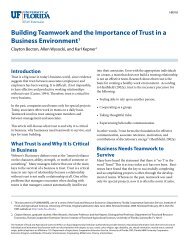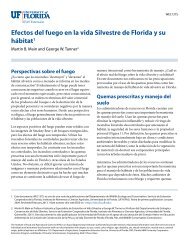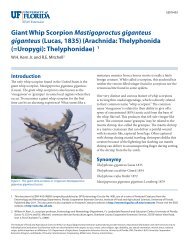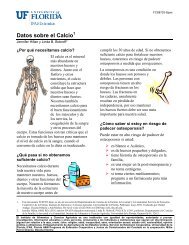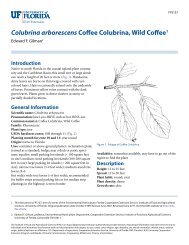Boisduval Scale, Diaspis boisduvalii Signoret - EDIS - University of ...
Boisduval Scale, Diaspis boisduvalii Signoret - EDIS - University of ...
Boisduval Scale, Diaspis boisduvalii Signoret - EDIS - University of ...
Create successful ePaper yourself
Turn your PDF publications into a flip-book with our unique Google optimized e-Paper software.
EENY467<br />
<strong>Boisduval</strong> <strong>Scale</strong>, <strong>Diaspis</strong> <strong>boisduvalii</strong> <strong>Signoret</strong> (Insecta:<br />
Hemiptera: Diaspididae) 1<br />
Adriana Espinosa, Heidi Bowman, Amanda Hodges and Greg Hodges 2<br />
Introduction<br />
The boisduval scale, <strong>Diaspis</strong> <strong>boisduvalii</strong><br />
<strong>Signoret</strong>, is an economically important pest <strong>of</strong><br />
orchids, and was reported as the most important<br />
insect pest <strong>of</strong> orchids in Florida (Dekle 1965). Miller<br />
and Davidson (2005) list boisduval scale as one <strong>of</strong><br />
the 43 most serious worldwide armored scale pests.<br />
Figure 1. Adult female boisduval scales, <strong>Diaspis</strong><br />
<strong>boisduvalii</strong> <strong>Signoret</strong> on banana fruit. Photograph by: Lyle J.<br />
Buss, <strong>University</strong> <strong>of</strong> Florida<br />
Distribution<br />
The boisduval scale occurs throughout the<br />
tropics, and as a greenhouse pest in more temperate<br />
climates (Dekle 1965, Miller and Davidson 2005).<br />
Description<br />
Females are white to light yellow, approximately<br />
0.05-0.09 inches (1.2-2.25 mm) in diameter, circular<br />
or oval in shape, and covered with a centrally located,<br />
white-transparent, flat circular or oval shed skin.<br />
When the scale cover is removed, a single, horn-like<br />
projection on either side <strong>of</strong> the body, near the head<br />
and thorax may be visible (Dekle 1965, Howard et al.<br />
2001, Miller and Davidson 2005).<br />
Males are oval to elongate in shape, with a white<br />
cover and marginal shed skin. Males measure<br />
approximately 0.04 inches (1mm) in length.<br />
1. This document is EENY-467 (IN838), one <strong>of</strong> a series <strong>of</strong> Featured Creatures from the Entomology and Nematology Department, Florida Cooperative<br />
Extension Service, Institute <strong>of</strong> Food and Agricultural Sciences, <strong>University</strong> <strong>of</strong> Florida. Published: November 2009. Revised June 2010. This document is<br />
also available on Featured Creatures website at http://entomology.ifas.ufl.edu/creatures. Please visit the <strong>EDIS</strong> website at http://edis.ifas.ufl.edu and the<br />
Entomology and Nematology Department website at http://entnemdept.ifas.ufl.edu/.<br />
2. Adriana Espinosa, former extension assistant; Heidi Bowman, graduate student; and Amanda Hodges, SPDN assistant director in entomology and<br />
training/education, <strong>University</strong> <strong>of</strong> Florida; Greg Hodges, Florida Department <strong>of</strong> Agriculture & Consumer Services, Division <strong>of</strong> Plant Industry.<br />
The Institute <strong>of</strong> Food and Agricultural Sciences (IFAS) is an Equal Opportunity Institution authorized to provide research, educational information and<br />
other services only to individuals and institutions that function with non-discrimination with respect to race, creed, color, religion, age, disability, sex,<br />
sexual orientation, marital status, national origin, political opinions or affiliations. U.S. Department <strong>of</strong> Agriculture, Cooperative Extension Service,<br />
<strong>University</strong> <strong>of</strong> Florida, IFAS, Florida A. & M. <strong>University</strong> Cooperative Extension Program, and Boards <strong>of</strong> County Commissioners Cooperating. Millie<br />
Ferrer-Chancy, Interm Dean
<strong>Boisduval</strong> <strong>Scale</strong>, <strong>Diaspis</strong> <strong>boisduvalii</strong> <strong>Signoret</strong> (Insecta: Hemiptera: Diaspididae) 2<br />
Figure 2. Adult female boisduval scales, <strong>Diaspis</strong><br />
<strong>boisduvalii</strong> <strong>Signoret</strong> on banana fruit. Photograph by: Lyle J.<br />
Buss, <strong>University</strong> <strong>of</strong> Florida<br />
Figure 3. Adult female boisduval scales, <strong>Diaspis</strong><br />
<strong>boisduvalii</strong> <strong>Signoret</strong>, with exuviae present. A<br />
centrally-located circle shape is part <strong>of</strong> the exuviae.<br />
Photograph by: <strong>University</strong> <strong>of</strong> Florida<br />
Life Cycle<br />
Each adult female may produce up to 200 eggs<br />
and live as long as seven months. Eggs hatch within<br />
five to seven days and become crawlers. Egg color<br />
depends upon maturity, and ranges from clear to<br />
yellow, and finally orange. The development from<br />
egg to the adult stage averages 33 days for males and<br />
50 days for females (Miller and Davidson 2005).<br />
Hosts<br />
This species has been recorded in over 15<br />
families and 65 genera in Florida alone, but is most<br />
commonly found on orchids and palms.<br />
Figure 4. Yellow colored body <strong>of</strong> the adult female<br />
boisduval scale, <strong>Diaspis</strong> <strong>boisduvalii</strong> <strong>Signoret</strong>. The<br />
oval-shaped cover has been removed. Photograph by:<br />
Avas Hamon Florida Department <strong>of</strong> Agriculture and<br />
Consumer Services, Division <strong>of</strong> Plant Industry<br />
Figure 5. Cluster <strong>of</strong> male boisduval scales, <strong>Diaspis</strong><br />
<strong>boisduvalii</strong> <strong>Signoret</strong>, on Cattleya leaf. Notice the "fluffy" or<br />
"cottony" appearance. Photograph by: Heidi M. Bowman,<br />
<strong>University</strong> <strong>of</strong> Florida<br />
Figure 6. Male, female, and crawler life stages <strong>of</strong><br />
boisduval scale, <strong>Diaspis</strong> <strong>boisduvalii</strong> <strong>Signoret</strong>, on Cattleya<br />
leaf. Photograph by: Heidi M. Bowman, <strong>University</strong> <strong>of</strong><br />
Florida
<strong>Boisduval</strong> <strong>Scale</strong>, <strong>Diaspis</strong> <strong>boisduvalii</strong> <strong>Signoret</strong> (Insecta: Hemiptera: Diaspididae) 3<br />
Within the palm hosts (family Arecaceae) the<br />
following genera are susceptible (Howard et al. 2001,<br />
Miller and Davidson 2005):<br />
• Acoelorraphe<br />
• Acrocomia<br />
• Archontophoenix<br />
• Areca<br />
• Bactris<br />
• Butia - pindo palm<br />
• Caryota - fishtail palms<br />
• Chamaedorea<br />
• Chamaerops - European fan palm or<br />
Mediterranean fan palm<br />
• Cocos - coconut palm<br />
• Corypha - gebang palm, buri palm or tailpot<br />
palm<br />
• Dictyosperma<br />
• Dypsis<br />
• Elaeis - oil palms<br />
• Euterpe<br />
• Howea<br />
• Hyophorbe<br />
• Latania - latan palm<br />
• Livistona<br />
• Nannorrhops - mazari palm<br />
• Phoenix<br />
• Ptychosperma<br />
• Rhapidophyllum - needle palm<br />
• Raphis<br />
• Roystonea - royal palms<br />
• Sabal - palmetto or fan palms<br />
• Syagrus<br />
• Thrinax<br />
• Trachycarpus - fan palms<br />
• Washingtonia<br />
Recorded orchid hosts (Orchidaceae) include the<br />
following genera:<br />
• Acineta<br />
• Angraecum<br />
• Anguloa<br />
• Bletia<br />
• Brassavola<br />
• Brassia<br />
• Brassocattleya<br />
• Broughtonia<br />
• Bulbophyllum<br />
• Cattleya<br />
• Caularthron<br />
• Coelogyne<br />
• Cycnoches<br />
• Cymbidium<br />
• Dendrobium<br />
• Encyclia<br />
• Epidendum<br />
• Laelia<br />
• Maxillaria<br />
• Miltonia
<strong>Boisduval</strong> <strong>Scale</strong>, <strong>Diaspis</strong> <strong>boisduvalii</strong> <strong>Signoret</strong> (Insecta: Hemiptera: Diaspididae) 4<br />
• Ne<strong>of</strong>inetia<br />
• Odontoglossum<br />
• Oncidium<br />
• Ornithidium<br />
• Peristeria<br />
• Pleurothallis<br />
• Renanthera<br />
• Rhynchostylis<br />
• Schomburgkia<br />
• Sophronitis<br />
• Stanhopea<br />
• Trichopilia<br />
• Vanda<br />
• Xylobium<br />
Other recorded host plant families include:<br />
• Agavaceae<br />
• Amaryllidaceae - Agave sp.<br />
• Anacardiaceae - Mangifera indica, mango;<br />
Schinus sp., pepper trees<br />
• Araliaceae - Hedera helix, common ivy<br />
• Asteraceae - Baccharis sp.<br />
• Bromeliaceae - Aechmea, Ananas, Aregelia,<br />
Billbergia, Bromelia, Catopsis, Guzmania,<br />
Neoglaziovia, Pitcairnia, Puya, Ronnbergia,<br />
Tillandsia, and Vriesia species<br />
• Cactaceae<br />
• Cyperaceae<br />
• Fabaceae - Acacia, Baikiaea, Cassia, and<br />
Leucaena species<br />
• Heliconiaceae<br />
• Lauraceae - Persea sp.<br />
• Liliaceae<br />
• Moraceae - Ficus sp.<br />
• Musaceae - Musa sp.<br />
• Rosaceae - Rosa sp.<br />
• Rubiaceae - C<strong>of</strong>fea, Dracaena, and Citrus<br />
species<br />
• Vitaceae - Vitis sp.<br />
A full listing <strong>of</strong> recorded hosts for boisduval<br />
scale is available at: <strong>Scale</strong>Net: A Database <strong>of</strong> <strong>Scale</strong><br />
Insects <strong>of</strong> the World.<br />
Damage<br />
<strong>Boisduval</strong> scales are normally found on the<br />
leaves and stems <strong>of</strong> palms. For orchids, this scale<br />
tends to prefer the leaf midrib and the portion <strong>of</strong> the<br />
petiole that is covered by the sheath. <strong>Boisduval</strong> scale<br />
is also capable <strong>of</strong> infesting orchid pseudobulbs and<br />
all aerial portions <strong>of</strong> the plant, including bark and<br />
fruit (Miller and Davidson 2005).<br />
Figure 7. Chlorosis and "pitting" caused by boisduval<br />
scale, <strong>Diaspis</strong> <strong>boisduvalii</strong> <strong>Signoret</strong>, feeding on Cattleya<br />
leaf. Photograph by: Heidi M. Bowman, <strong>University</strong> <strong>of</strong><br />
Florida<br />
Management<br />
Various cultural, biological, and chemical<br />
control options may be effective for management.<br />
Nutritional problems may enhance a host's<br />
susceptibility.
<strong>Boisduval</strong> <strong>Scale</strong>, <strong>Diaspis</strong> <strong>boisduvalii</strong> <strong>Signoret</strong> (Insecta: Hemiptera: Diaspididae) 5<br />
Cultural control. Exclusion is the first measure<br />
to be taken to avoid boisduval scale infestation.<br />
Carefully examine all plants and propagative<br />
materials before purchasing them. However, buyer<br />
beware, it is easy to miss scales located underneath<br />
leaf sheaths and not all life stages are visible to the<br />
unaided eye. New plants should be isolated from<br />
collections and nursery stock for at least two weeks to<br />
ensure they are pest free. Spacing plants so that their<br />
leaves do not touch can help avoid biosduval crawlers<br />
moving from infested plants onto clean neighboring<br />
plants (Beardsley and Gonzalez 1975). The crawlers<br />
can also move from infested to clean plants through<br />
strong wind currents in greenhouses and rooms. If it<br />
is possible, isolate infested plants to avoid biosduval<br />
scale spread and begin a treatment regiment.<br />
Biological control. Coccidencyrtus sp.<br />
(Hymenoptera: Encyrtidae) have been reported as<br />
parasites <strong>of</strong> boisduval scale (Miller and Davidson<br />
2005, Tenbrink and Hara 1992).<br />
Figure 8. Coccidencytrus sp., a parasitoid <strong>of</strong> the boisduval<br />
scale, <strong>Diaspis</strong> <strong>boisduvalii</strong> <strong>Signoret</strong>. Photograph by: Avas<br />
Hamon, Florida Department <strong>of</strong> Agriculture and Consumer<br />
Services, Division <strong>of</strong> Plant Industry<br />
Chemical control. Horticultural oils are <strong>of</strong>ten<br />
very effective for controlling scale insects, but<br />
product labels should be carefully followed. For<br />
example, dormant oils applied to the actively growing<br />
stage <strong>of</strong> a plant may result in a burning effect on the<br />
plant material. Because crawlers tend to establish<br />
themselves on the upper and lower leaf surfaces, near<br />
the base <strong>of</strong> the plant, and in leaf sheaths, thorough<br />
spray coverage is important.<br />
For small collections, using 70% isopropyl<br />
alcohol and a gentle cloth or cotton swab to wipe<br />
away the scales can provide effective control.<br />
However, some s<strong>of</strong>t-leaved orchids may be damaged<br />
by isopropyl.<br />
The American Orchid Society has a helpful,<br />
online video demonstrating how to treat scales with<br />
alcohol (AOS Video Library 2008).<br />
If a chemical application is used, remember that<br />
timing the application to target the immature or<br />
crawler life stage may be critical for appropriate<br />
control. As biosduval scale is an armored scale, the<br />
waxy covering may still be present even after it has<br />
been effectively killed.<br />
Florida Insect Management Guide for<br />
ornamentals<br />
American Orchid Society management<br />
recommendations<br />
Selected References<br />
• AOS Video Library. (2008). <strong>Boisduval</strong> <strong>Scale</strong>.<br />
American Orchid Society.<br />
http://www.aos.org/AM/<br />
Template.cfm?Section=Video_Library&CONTE<br />
NTID=6350&TEMPLATE=/CM/<br />
ContentDisplay.cfm (28 October 2009).<br />
• Beardsley Jr JW, Gonzalez RH. 1975. The<br />
biology and ecology <strong>of</strong> armored scales. Annual<br />
Review <strong>of</strong> Entomology 20: 47-73.<br />
• Buss EA, Turner JC. (June 2006). <strong>Scale</strong> insects<br />
and mealybugs on ornamental plants. <strong>EDIS</strong>.<br />
http://edis.ifas.ufl.edu/MG005 (28 October<br />
2009).<br />
• Cating RA, Hoy MA, Palmateer AJ. (2010).<br />
Silwet L-77 improves the efficacy <strong>of</strong> horticultral<br />
oils for control <strong>of</strong> <strong>Boisduval</strong> scale <strong>Diaspis</strong><br />
<strong>boisduvalii</strong> (Hemiptera: Diaspididae) and the flat<br />
mite Tenuipalpus pacificus (Arachnida: Acari:<br />
Tenuipalpidae) on orchids. Florida Entomologist<br />
93. http://www.fcla.edu/FlaEnt/fe93p100.pdf (7<br />
June 2010).
<strong>Boisduval</strong> <strong>Scale</strong>, <strong>Diaspis</strong> <strong>boisduvalii</strong> <strong>Signoret</strong> (Insecta: Hemiptera: Diaspididae) 6<br />
• Dekle GW. 1965. Arthropods <strong>of</strong> Florida and<br />
Neighboring Land Areas: Florida Armored <strong>Scale</strong><br />
Insects. Vol. 3. Florida Department <strong>of</strong><br />
Agriculture & Consumer Services, Division <strong>of</strong><br />
Plant Industry. Gainesville, FL.<br />
• Howard FW, Moore D, Giblin-Davis RM, Abad<br />
R. 2001. Insects on Palms. CABI Publishing,<br />
Wallingford, UK. 400 pp.<br />
• Johnson PJ. (November 2001). <strong>Scale</strong>. American<br />
Orchid Society.<br />
http://www.aos.org/AM/<br />
Template.cfm?Section=Search&template=/CM/<br />
HTMLDisplay.cfm&ContentID=5671 (28<br />
October 2009).<br />
• Miller DR, Gimpel ME. (2009). Diaspididae:<br />
Diaspidinae and Leucaspidinae. <strong>Scale</strong>Net.<br />
http://www.sel.barc.usda.gov/scalenet/<br />
scalenet.htm (3 September 2009).<br />
• Miller DR, Davidson JA. 2005. Armored <strong>Scale</strong><br />
Insect Pests <strong>of</strong> Trees and Shrubs (Hemiptera:<br />
Diaspididae). Cornell <strong>University</strong> Press. Ithaca,<br />
NY. 456 pp.<br />
• Tenbrink VL, Hara AH. (March 1992). <strong>Diaspis</strong><br />
boisduvalli (<strong>Signoret</strong>). Crop Knowledge Master.<br />
http://www.extento.hawaii.edu/kbase/crop/Type/<br />
d_boisdu.htm (4 November 2009).


